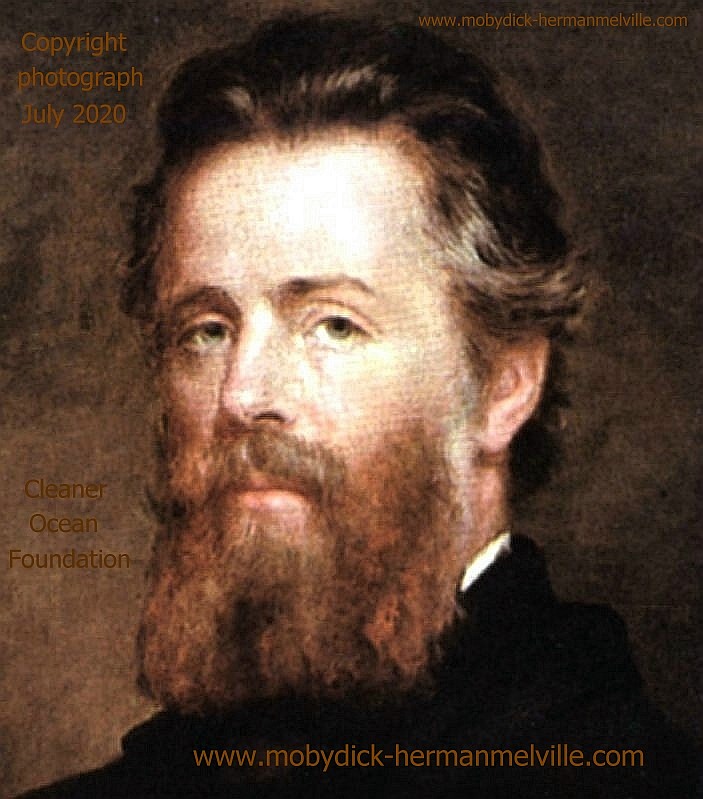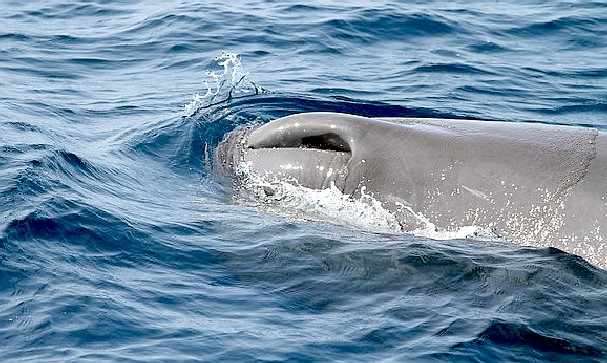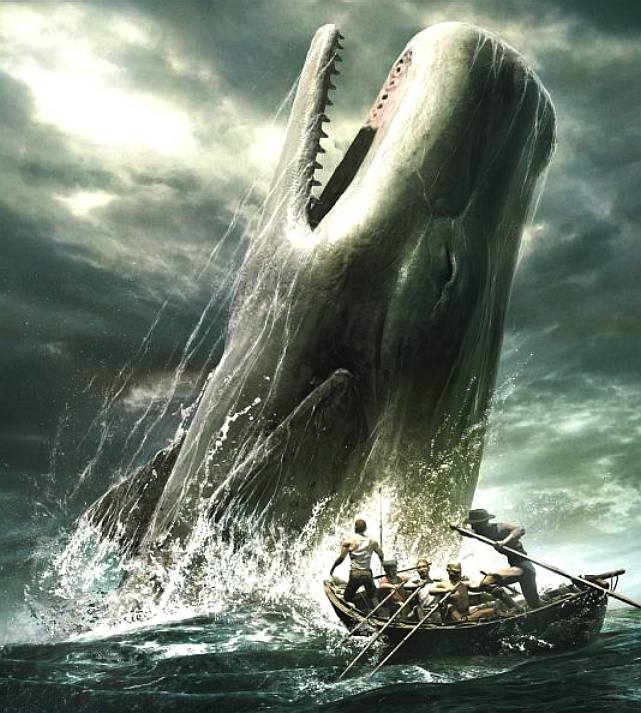|
Chapter 68 - THE BLANKET
Please use our A-Z INDEX to navigate this site
|
Herman Melville was the author of a story about what we'd now consider an illegal activity, the commercial hunting of whales for oil and meat. Whaling is still carried out by Japan, Iceland and Canada, among other nations, though most nations voluntarily abstain in the interests of conserving these magnificent animals - as per International Whaling Commission guidelines.
Back <<<
I have given no small attention to that not unvexed subject, the skin of the whale. I have had controversies about it with experienced whalemen afloat, and learned naturalists ashore. My original opinion remains unchanged; but it is only an opinion.
I have several such dried bits, which I use for marks in my whale-books. It is transparent, as I said before; and being laid upon the printed page, I have sometimes pleased myself with fancying it exerted a magnifying influence. At any rate, it is pleasant to read about whales through their own spectacles, as you may say. But what I am driving at here is this. That same infinitely thin, isinglass substance, which, I admit, invests the entire body of the whale, is not so much to be regarded as the skin of the creature, as the skin of the skin, so to speak; for it were simply ridiculous to say, that the proper skin of the tremendous whale is thinner and more tender than the skin of a new-born child. But no more of this.
Nor is this all. In some instances, to the quick, observant eye, those linear marks, as in a veritable engraving, but afford the ground for far other delineations. These are hieroglyphical; that is, if you call those mysterious cyphers on the walls of pyramids hieroglyphics, then that is the proper word to use in the present connexion. By my retentive memory of the hieroglyphics upon one Sperm Whale in particular, I was much struck with a plate representing the old Indian characters chiselled on the famous hieroglyphic palisades on the banks of the Upper Mississippi. Like those mystic rocks, too, the mystic-marked whale remains undecipherable. This allusion to the Indian rocks reminds me of another thing. Besides all the other phenomena which the exterior of the Sperm Whale presents, he not seldom displays the back, and more especially his flanks, effaced in great part of the regular linear appearance, by reason of numerous rude scratches, altogether of an irregular, random aspect.
I should say that those New England rocks on the sea-coast, which Agassiz imagines to bear the marks of violent scraping contact with vast floating icebergs—I should say, that those rocks must not a little resemble the
Sperm Whale in this particular. It also seems to me that such scratches in the whale are probably made by hostile contact with other whales; for I have most remarked them in the large, full-grown bulls of the species.
Next
>>>
BOOK CHAPTERS CHAPTER 26. Knights and Squires. CHAPTER 27. Knights and Squires. CHAPTER 29. Enter Ahab; to Him, Stubb. CHAPTER 39. First Night Watch. CHAPTER 40. Midnight, Forecastle. CHAPTER 42. The Whiteness of The Whale. CHAPTER 48. The First Lowering. CHAPTER 50. Ahab's Boat and Crew. Fedallah. CHAPTER 54. The Town-Ho's Story. CHAPTER 55. Of the Monstrous Pictures of Whales. CHAPTER 56. Of the Less Erroneous Pictures of Whales, and the True CHAPTER 57. Of Whales in Paint; in Teeth; in Wood; in Sheet-Iron; in CHAPTER 61. Stubb Kills a Whale. CHAPTER 65. The Whale as a Dish. CHAPTER 66. The Shark Massacre. CHAPTER 71. The Jeroboam's Story. CHAPTER 73. Stubb and Flask Kill a Right Whale; and Then Have a Talk CHAPTER 74. The Sperm Whale's Head—Contrasted View. CHAPTER 75. The Right Whale's Head—Contrasted View. CHAPTER 76. The Battering-Ram. CHAPTER 77. The Great Heidelburgh Tun. CHAPTER 78. Cistern and Buckets. CHAPTER 81. The Pequod Meets The Virgin. CHAPTER 82. The Honour and Glory of Whaling. CHAPTER 83. Jonah Historically Regarded. CHAPTER 88. Schools and Schoolmasters. CHAPTER 89. Fast-Fish and Loose-Fish. CHAPTER 91. The Pequod Meets The Rose-Bud. CHAPTER 94. A Squeeze of the Hand. CHAPTER 98. Stowing Down and Clearing Up. CHAPTER 102. A Bower in the Arsacides. CHAPTER 103. Measurement of The Whale's Skeleton. CHAPTER 104. The Fossil Whale. CHAPTER 105. Does the Whale's Magnitude Diminish?—Will He Perish? CHAPTER 108. Ahab and the Carpenter. CHAPTER 109. Ahab and Starbuck in the Cabin. CHAPTER 110. Queequeg in His Coffin. CHAPTER 115. The Pequod Meets The Bachelor. CHAPTER 120. The Deck Towards the End of the First Night Watch. CHAPTER 121. Midnight.—The Forecastle Bulwarks. CHAPTER 122. Midnight Aloft.—Thunder and Lightning. CHAPTER 125. The Log and Line. CHAPTER 128. The Pequod Meets The Rachel. CHAPTER 131. The Pequod Meets The Delight. CHAPTER 133. The Chase—First Day. CHAPTER 134. The Chase—Second Day. CHAPTER 135. The Chase.—Third Day.
Moby Dick is the antogonist in this story of a great white 'bull' sperm whale that fought back at whalers who tried to harpoon him.
The idea came to Herman Melville after he spent time on a commercial whaler, where stories abounded of the sinking of the Essex in 1821 and Mocha Dick, a giant sperm whale that sank around 20 ships, before being harpooned in 1838.
Herman realised how fixated the sailors became, and he also became with the thought that there was a whale that nobody could catch, that represented a real risk to the whalers hunting whales, in that it was more sport than commercial operations.
Without any doubt this is one of the greatest novels coming out of America at this time and way off the beaten track, making it so interesting, reflecting the state of whaling and the economic importance in the developing the nation - giving the general public a taste of something adventurous that most people never think about.
Many films and graphic novel adaptations have been inspired by the writings of Herman Melville, from Marvel and Disney comics with good cause.
One such production in 2020 is a graphic novel about a giant humpback whale called Kulo Luna, that sinks a modern whaling boat, much as depicted in Herman Melville's Moby Dick, except that is this day and age whales have explosive harpoons to contend with, and sonar, from which there is no escape.
Please use our A-Z INDEX to navigate this site
|
|
This website is Copyright © 2020 Cleaner Ocean Foundation Ltd and Jameson Hunter Ltd
|


